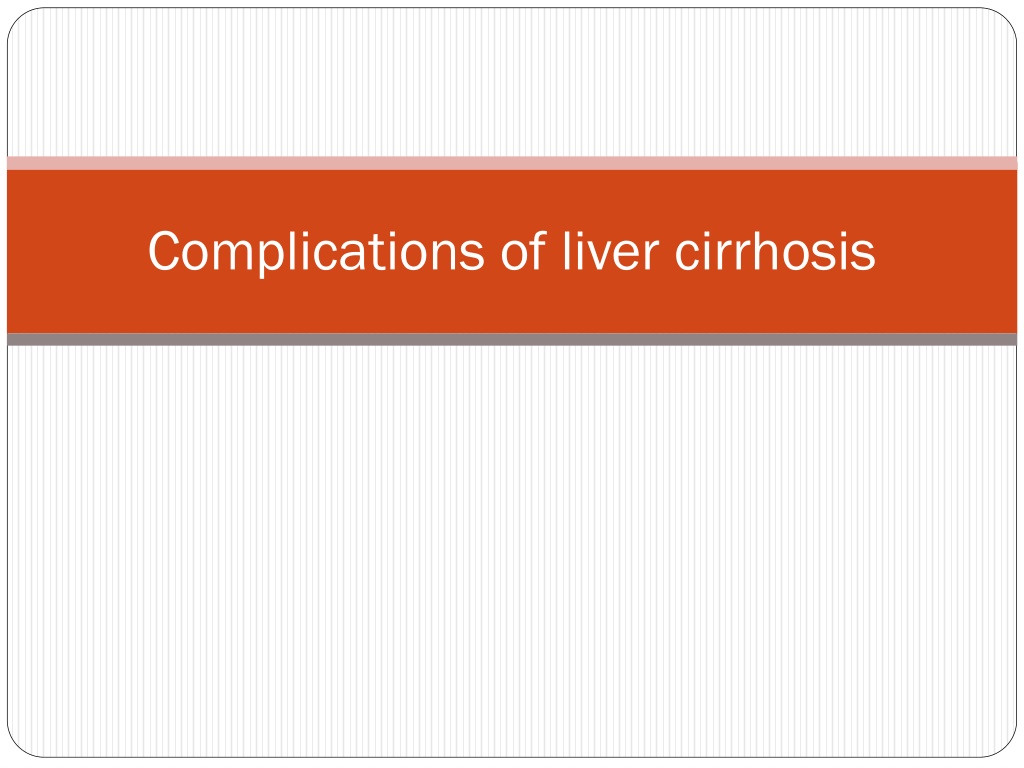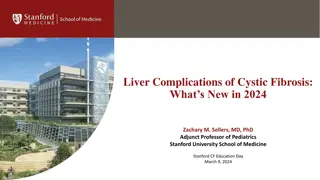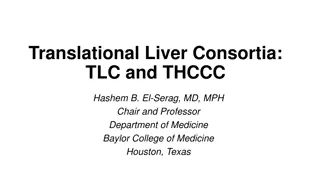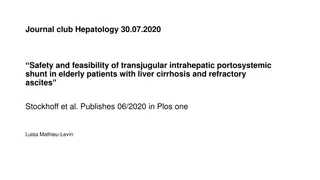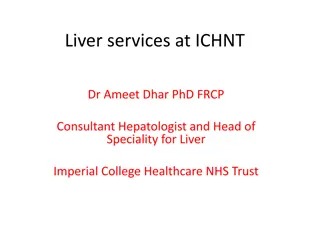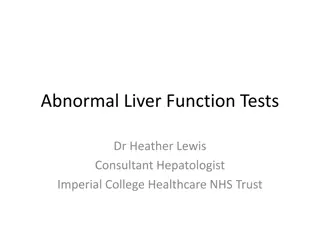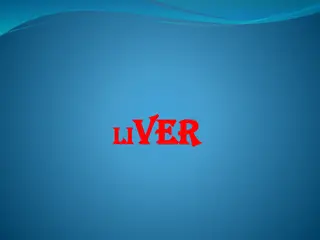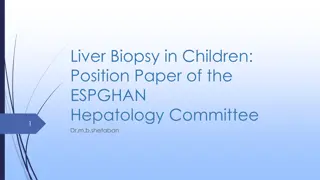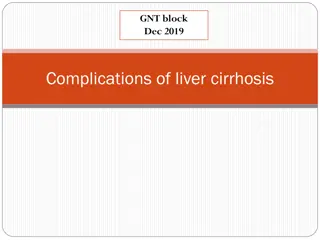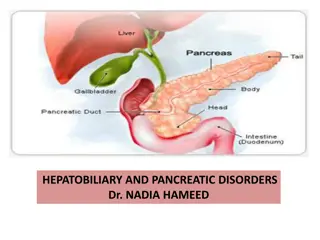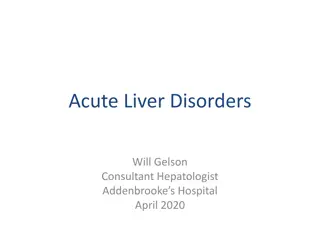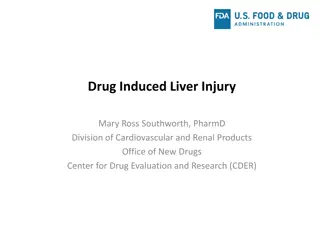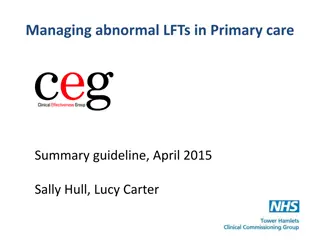Understanding Complications of Liver Cirrhosis
Recognize major complications of liver cirrhosis including hepatic failure, portal hypertension, ascites, hepatorenal syndrome, and esophageal varices. Learn about the pathogenetic mechanisms, clinical features, and pathological findings associated with these complications.
Download Presentation

Please find below an Image/Link to download the presentation.
The content on the website is provided AS IS for your information and personal use only. It may not be sold, licensed, or shared on other websites without obtaining consent from the author. Download presentation by click this link. If you encounter any issues during the download, it is possible that the publisher has removed the file from their server.
E N D
Presentation Transcript
Complications of liver cirrhosis Recognize the major complications of cirrhosis Understand the pathogenetic mechanisms underlying the occurrence of the complications Recognize the clinical features inherent to the above mentioned complications Describe the pathological findings of the different complications
. Complications of liver cirrhosis 1. Hepatic failure a. Coagulopathy b. Hypoalbuminemia c. Hepatic encephalopathy Portal hypertension: a. Variceal bleeding b. Splenomegaly c. Hemorrhoids d. Periumbilical venous collaterals (caput medusa) Ascites Hepatorenal syndrome Hyperestrinism in males Hepatocellular carcinoma Spontaneous bacterial peritonitis Jaundice and cholestasis 2. 3. 4. 5. 6. 7. 8.
Complications of liver cirrhosis PORTAL HYPERTENSION :
Complications of liver cirrhosis PORTAL HYPERTENSION : PORTAL HYPERTENSION : Resistance to blood flow prehepatic, intrahepatic, and posthepatic The dominant intrahepatic cause is cirrhosis (This is accounting for most cases of portal hypertension) Portosystemic shunts develop when blood flow is reversed from the portal to systemic circulation. due to intrasinusoidal hypertension from regenerative nodule compression
Complications of liver cirrhosis ESOPHAGEAL VARICES
Complications of liver cirrhosis ESOPHAGEAL VARICES: ESOPHAGEAL VARICES: Instead of returning directly to the heart, venous blood from the GI tract is delivered to the liver via the portal vein before reaching the inferior vena cava. This circulatory pattern is responsible for the first- pass effect in which drugs and other materials absorbed in the intestines are processed by the liver before entering the systemic circulation..
Complications of liver cirrhosis ESOPHAGEAL VARICES: ESOPHAGEAL VARICES: Diseases that impede this flow cause portal hypertension and can lead to the development of esophageal varices, an important cause of esophageal bleeding
Complications of liver cirrhosis Portal hypertention Portal hypertention Portosystemic Shunt Portosystemic Shunt Abdominal wall collaterals (caput medusae) Rectum ( hemorrhoids) Cardioesophageal junction ( esophagogastric varices)
Complications of liver cirrhosis ESOPHAGEAL VARICES: ESOPHAGEAL VARICES: Pathogenesis Portal hypertension results in the development of collateral channels at sites where the portal and caval systems communicate. Although these collateral veins allow some drainage to occur, they lead to development of a congested subepithelial and submucosal venous plexus within the distal esophagus. (varices): 90% of cirrhotic patients develop varices most commonly in association with alcoholic liver disease Hepatic schistosomiasis
Complications of liver cirrhosis ESOPHAGEAL VARICES ESOPHAGEAL VARICES Morphology: Varices can be detected by venogram: tortuous dilated veins lying primarily within the submucosa of the distal esophagus and proximal stomach. Venous channels directly beneath the esophageal epithelium may also become massively dilated. Varices may not be grossly obvious in surgical or postmortem specimens, because they collapse in the absence of blood flow . Variceal rupture results in hemorrhage into the lumen or esophageal wall, in which case the overlying mucosa appears ulcerated and necrotic. If rupture has occurred in the past, venous thrombosis, inflammation, and evidence of prior therapy may also be present.
Complications of liver cirrhosis ESOPHAGEAL VARICES: ESOPHAGEAL VARICES: Clinical features: Asymptomatic or rupture- massive hematemesis. Inflammatory erosion of thinned overlying mucosa Increased tension in progressively dilated veins Increased vascular hydrostatic pressure associated with vomiting are likely to contribute to medical emergency that is treated by any of several methods: 1. Sclerotherapy 2. Endoscopic balloon tamponade 3. Endoscopic rubber band ligation
Complications of liver cirrhosis ESOPHAGEAL VARICES: ESOPHAGEAL VARICES: Half of patients die from the first bleeding episode either as a direct consequence of hemorrhage or following hepatic coma triggered by hypovolemic shock. Additional 50% within 1 year. Each episode has a similar rate of mortality. Over half of deaths among individuals with advanced cirrhosis result from variceal rupture.
ESOPHAGEAL VARICES: Complications of liver cirrhosis
Complications of liver cirrhosis Splenomegaly: Long-standing congestion may cause congestive splenomegaly (spleen weight may reach up to 1000 gm) The massive splenomegaly may induce hematologic abnormalities attributable to hypersplenism, such as thrombocytopenia or pancytopenia
Complications of liver cirrhosis Ascites is the accumulation of excess fluid in the peritoneal cavity: 85% of cases are caused by cirrhosis. Serous: less than 3 gm/dL of protein Pathogenesis: Increase in portal vein hydrostatic pressure Decreases oncotic pressure Liver is unable to metabolize aldosterone
Complications of liver cirrhosis Spontaneous bacterial peritonitis
Complications of liver cirrhosis JAUNDICE AND CHOLESTASIS
Complications of liver cirrhosis JAUNDICE AND CHOLESTASIS: JAUNDICE AND CHOLESTASIS: Jaundice and icterus: a yellowish or greenish pigmentation of the skin and sclera of the eyes respectively due to high bilirubin levels. Cholestasis, characterized by systemic retention of not only bilirubin but also other solutes eliminated in bile.
Bilirubin metabolism and elimination
Complications of liver cirrhosis Cause of Jaundice 1. Prehepatic causes of jaundice: Bilirubinoverproduction due to hemolysis and hematoma resorption, lead to elevated levels of unconjugated (indirect) bilirubin. 2. Intrahepatic disorders can lead to unconjugated or conjugated hyperbilirubinemia. The conjugated (direct) bilirubin level is often elevated by alcohol, infectious hepatitis, drug reactions, and autoimmune disorders. 3. Posthepatic disorders (Obstruction of the flow of bile) can cause conjugated hyperbilirubinemia. Gallstone formation is the most common posthepatic process that causes jaundice; however, the differential diagnosis also includes serious conditions such as biliary tract infection, pancreatitis, and malignancies
Complications of liver cirrhosis Coagulopathy
Coagulopathy The liver is the source of a number of coagulation factors that decline in the face of liver failure, leading to easy bruising and bleeding
Complications of liver cirrhosis Hepatic encephalopathy
Complications of liver cirrhosis Hepatic encephalopathy spectrum of disturbances in consciousness ranging from subtle behavioral abnormalities, to confusion and stupor, to coma and death. may develop over days, weeks, or a few months Due to elevated ammonia levels in blood and the central nervous system and brain edema. Protein from dietary sources or blood in gastrointestinal tract leads to increased bacterial conversion of urea into ammonia (cannot be metabolized in sick liver and with portosystemic shunts, ammonia go to brain)
Complications of liver cirrhosis Hepatorenal Hepatorenal syndrome syndrome: :
Complications of liver cirrhosis Hepatorenal Hepatorenal syndrome: syndrome: Appearance of renal failure in individuals with severe chronic liver disease - no intrinsic morphologic or functional causes for the renal failure. The incidence of this syndrome is about 8% per year among patients who have cirrhosis and ascites
Complications of liver cirrhosis Hepatorenal Hepatorenal syndrome: syndrome: Decreased renal perfusion pressure due to systemic vasodilation Activation of the renal sympathetic nervous system with vasoconstriction of the afferent renal arterioles Increased synthesis of renal vasoactive mediators, that decrease glomerular filtration.
Complications of liver cirrhosis Hepatocellular Carcinoma
Complications of liver cirrhosis Conclusion
